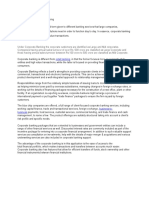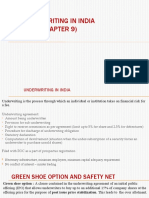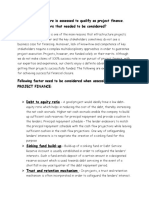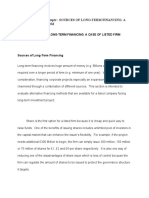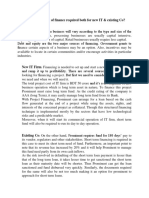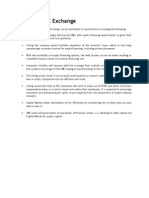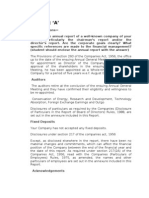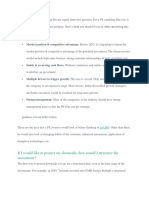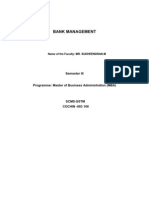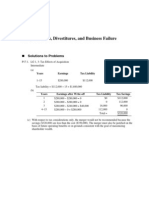Definition of 'Cost of Acquisition': Amortization of Telecommunications Spectrum Licenses
Definition of 'Cost of Acquisition': Amortization of Telecommunications Spectrum Licenses
Uploaded by
Nadendla NaveenCopyright:
Available Formats
Definition of 'Cost of Acquisition': Amortization of Telecommunications Spectrum Licenses
Definition of 'Cost of Acquisition': Amortization of Telecommunications Spectrum Licenses
Uploaded by
Nadendla NaveenOriginal Title
Copyright
Available Formats
Share this document
Did you find this document useful?
Is this content inappropriate?
Copyright:
Available Formats
Definition of 'Cost of Acquisition': Amortization of Telecommunications Spectrum Licenses
Definition of 'Cost of Acquisition': Amortization of Telecommunications Spectrum Licenses
Uploaded by
Nadendla NaveenCopyright:
Available Formats
Definition of 'Cost Of Acquisition'
A business sales term referring to the expense required to attain a customer or a sale. In setting a marketing and sales strategy, a company must decide what the maximum cost of acquisition will be, which effectively determines the highest amount the company is willing to spend to
attain each customer.
Investopedia explains 'Cost Of Acquisition'
This cost is tied to marketing and sales campaigns because the more streamlined those campaigns become, the lower the customer cost of acquisition will be. Conversely, in a highbudget marketing and sales campaign, the acquisition cost may be relatively high depending on how many sales or customers the campaign draws in Read more: http://www.investopedia.com/terms/c/costofacquisition.asp#ixzz1rGfBw68l
Amortization of Telecommunications Spectrum Licenses We own the rights to use and operate specified spectrums in some jurisdictions over a certain period of time, through annual minimum fees plus a variable portion depending on the future revenues from the services. License fees payments, the discounted value of the fixed annual fees to be paid over the license period, and certain other direct costs incurred prior to the date the asset is ready for its intended use are capitalized. Capitalized license fees are amortized from the date the asset is ready for its intended use until the expiration of the license. Interest is accreted on the fixed annual fees and charged to interest expense. Variable license fees are recognized as period costs.
This excerpt taken from the HTX 20-F filed May 9, 2008.
Amortization of Telecommunications Spectrum Licenses We own the rights to use and operate specified spectrums in some jurisdictions over a certain period of time, through annual minimum fees plus a variable portion depending on the future revenues from the services. License fees payments, the discounted value of the fixed annual fees to be paid over the license period, and certain other direct costs incurred prior to the date the asset is ready for its intended use are capitalized. Capitalized license fees are amortized from the date the asset is ready for its intended use until the expiration of the license.
GROWTH CAPITAL AND EQUITY ASSISTANCE FOR MSMES (GEMS)
One of the major factors inhibiting the growth of Micro, Small and Medium Enterprises (MSMEs) is the non availability of adequate owners capital i.e margin. External equity i.e the PE/ VC investment is also rare due to various issues in MSMEs viz small ticket size, high transaction cost, difficulty in understanding equity related complexities in MSME promoters, valuation and exit issues, lack of preparedness/ willingness in promoters in diluting ownership/ control, etc. Due to shortfall in meeting margin requirements, MSMEs often languish to get adequate working capital, which is the life and blood of their business. MSMEs also find it difficult to raise loan assistance for other growth requirements viz investments in marketing, brand building, creating distribution network, technical know-how, software purchase, investment in energy efficiency and quality improvement equipments, R&D, etc., mainly as these investments by nature are non-asset creating (i.e. intangible assets) and hence do not provide security comfort to the lenders. To obviate the aforesaid problems of MSMEs, SIDBI has come out with a scheme Growth Capital and Equity assistance for MSMEs (GEMs). Under the scheme, assistance in the form of equity/ quasi-equity is provided to deserving MSMEs. In India, more than 90% of the MSMEs are constituted as partnership/ proprietorship concerns, where investment in pure equity form is difficult. Further, SIDBI also understands that most of MSME businesses in India are family owned with value built over generations. Due to these reasons, Indian MSMEs find it difficult to dilute large part of ownership and control in favour of an external entity. Looking to this, SIDBI, based on best global practices, has come out with various
innovative financial instruments for MSMEs of different sizes and constitutions, including Subordinated debt (SD)/ Optionally Convertible Subordinated Debt (OCSD), which is treated as quasi-equity by SIDBI. While SIDBI provides Equity/ equity linked assistance for deserving corporatised MSMEs, SD provides quasi equity support to all constitutions of MSMEs. Subordinated capital is a highly popular instrument among MSMEs globally, with minimal equity complexities and simpler documentation and hence quick to deliver and less costly for MSMEs. It is provided on the strength of business/ backing of cash flows rather than asset cover/ collateral security. The initial longer moratorium on principal installments ensures greater chances of success of the ventures. Apart from direct funding, SIDBI, in order to reach out to a wider segment of MSMEs, will use various delivery channels like VC Funds / NBFCs etc as Channel Partners, Credit Delivery Arrangements with select NBFCs for providing growth capital to MSMEs for their margin and other bonafide growth requirements.
Growth Capital and Equity Assistance Scheme for MSMEs (GEMs)
What is Growth Capital and Equity Assistance for MSMEs (GEMs)
GEMs is given on the strength of business model/management strength & is not dependent on asset cover/collateral. o It could be used to bridge the gap between the two chief sources of finance viz. bank loans (senior debt) and promoters capital. o SIDBI offers this assistance in form of mezzanine/ convertible instruments, subordinated debt and equity (in deserving cases). This quasiassistance is collateral free, has higher moratorium on repayment and a flexible structuring. In view of the above, the expected rate of return to SIDBI is higher than that on secured loan assistance.
Need for GEMs for MSMEs
o o o
Promoters financial resources are generally limited and might not meet the growth aspirations of the business. Hence the need for equity/quasi equity type of assistance to enable them to leverage it for conventional bank/debt funding. MajorityMSMEs are generally not able to raise external equity from Venture Capitalists / PE investors due to
various issues viz. valuation complexities, lack of clear exit options, small ticket/deal size, expensive due diligence etc. o Assistance for non asset creating investments is generally difficult under normal debt schemes. Large number of MSMEs have a non-corporate constitution and hence cannot raise equity capital.
Uses of GEMs
Bridging the gap in means of finance for scaling up/ expansion/ modernization projects. o For intangible investment viz. Marketing/R&D/product development/IPR filing etc o Working capital margin requirements. Normal Working capital requirements are not eligible under the scheme.
o
Products Subordinate debt(with/without conversion options) Mezzanine/ Convertible instruments viz Optionally Convertible Debt/ Debentures, Redeemable Preference Shares. Equity (on a selective basis) where business model/exit options clearly support such investment.
o o
Eligibility
o o
an MSME as per the definition of Government of India (MSMED Act) And SIDBIs existing customers (meeting internal rating criteria)
or Units with past 3 years of profitability and 2 years of satisfactory banking credit track record (meeting internal credit rating criteria)
o
Security (in case of debt based investments) Acceptable external rating from CRISIL, ICRA, D&B, SMERA etc would be desirable. No collaterals Residual charge on available assets of the beneficiary unit and assets created out of the assistanceSIDBI assistance Personal guarantee of the promoters Please see Interest rate structure chart
o o o
Rate of return Others terms
o o o o
Tenure of assistance could be upto 7 years (with upto 3 years moratorium on principal repayments) Subordinated Debt restricted to 1/3rd of Post project tangible net-worth@ of the unit. DER/ DSCR norms as per internal guidelines of the bank. MSMEs can access long term structured assistance especially for investments in intangible assets MSMEs can leverage sub debt assistance for raising higher
Advantages to
o o
MSMEs
debt funds from SIDBI As most of the structures are self liquidating in nature, MSMEs do not face various complexities viz. enterprise valuation, equon exit issues, etc. Customers desirous of availing assistance under GEMs may send brief information about their business as per Annexure enclosed. The duly filled, signed copy may be mailed/ sent to nearby SIDBI office. A copy may also be mailed to
How to approach SIDBI for Risk capital
o o
sfrc@sidbi.in for preliminary approval of SIDBI.
o
Once, the proposal is found in-principally eligible by SIDBI, the detailed application would be issued by SIDBI to the customer.
@ Post project Tangible net worth' would mean Tangible net worth as on date of last audited balance sheet + capital (including share premium) infused after the date of last audited balance sheet till the date of present proposal for assistance + additional capital (including share premium) proposed in the project. Tangible net worth means Capital + preference shares (excluding that part which is redeemable within 3 years) + Share premium + Reserves and Surplus Accumulated losses Revaluation reserves - Misc. exp. not written off Intangible/ Fictitious assets + capital inducted after date of last audited balance sheet.
You might also like
- MASA-Merger of HP - Compaq-A - B - Session 7-8-9-10Document44 pagesMASA-Merger of HP - Compaq-A - B - Session 7-8-9-10Anubhav AroraNo ratings yet
- Real Estate FinancingDocument29 pagesReal Estate FinancingRaymon Prakash100% (3)
- Introduction To Corporate Banking ServicesDocument14 pagesIntroduction To Corporate Banking Servicesbookworm2606100% (1)
- A Sample SWOT Analysis ExampleDocument14 pagesA Sample SWOT Analysis Examplemeghna15094589No ratings yet
- 3rd & 4th Sesion - UnderwritingDocument32 pages3rd & 4th Sesion - UnderwritingSuvajitLaikNo ratings yet
- SidbiDocument26 pagesSidbiAnand JoshiNo ratings yet
- Budgetary Control Katherine Jackson - FeedbackDocument20 pagesBudgetary Control Katherine Jackson - FeedbackkatieNo ratings yet
- Mf0017 & Merchant Banking and Financial ServicesDocument13 pagesMf0017 & Merchant Banking and Financial ServicesMadhusudhan GowdaNo ratings yet
- SIDBI NASSCOM Financing Initiative FAQsDocument2 pagesSIDBI NASSCOM Financing Initiative FAQsgvs_2000No ratings yet
- Structured FinanceDocument7 pagesStructured FinancePrakash BhushanNo ratings yet
- Fin Sight - Apr 2013Document4 pagesFin Sight - Apr 2013rohitgupta234No ratings yet
- Introduction To Raising FinanceDocument22 pagesIntroduction To Raising FinanceAshok KumarNo ratings yet
- Circular Risk Capital Assistance For Msme UnitsDocument7 pagesCircular Risk Capital Assistance For Msme Unitss.k.pandeyNo ratings yet
- Msme LoansDocument3 pagesMsme Loansustarm26No ratings yet
- Institute of Management Technology, Ghaziabad End Term Exam (Term - IV) Take Home Exam (Time Duration: 24 HRS) Batch 2019 - 21 Answer-SheetDocument5 pagesInstitute of Management Technology, Ghaziabad End Term Exam (Term - IV) Take Home Exam (Time Duration: 24 HRS) Batch 2019 - 21 Answer-SheetPuneet GargNo ratings yet
- Term Loans PPT 2003Document30 pagesTerm Loans PPT 2003gayathrihari100% (2)
- Revenue ModelDocument6 pagesRevenue ModelSayed Naved HaleemNo ratings yet
- MCO 07 EM 2024 @ignouallqueries1Document10 pagesMCO 07 EM 2024 @ignouallqueries1surbhi_sharma_2613No ratings yet
- SIDBIDocument5 pagesSIDBISambit SouravNo ratings yet
- Bmo Business Plan FeesDocument8 pagesBmo Business Plan Feesexllctqvf100% (1)
- Capital StructureDocument3 pagesCapital Structurenm.l.gavinoNo ratings yet
- FM - Sunita Mahajan PGPMX B2-18-20 - Individual AssignmentDocument8 pagesFM - Sunita Mahajan PGPMX B2-18-20 - Individual AssignmentSunita Mahajan PGPMX 2018 B2No ratings yet
- MGT 1002 Module-2Document58 pagesMGT 1002 Module-2Siva KishoreNo ratings yet
- Finance Case Study SampleDocument12 pagesFinance Case Study SampleHarshit DaveNo ratings yet
- #2 - What Do You Think This Company Does Right? What Do You Think We Do Wrong?Document8 pages#2 - What Do You Think This Company Does Right? What Do You Think We Do Wrong?helloNo ratings yet
- Lecture - Sources of FinanceDocument27 pagesLecture - Sources of FinanceNelson MapaloNo ratings yet
- Assignment - Financial MarketsDocument3 pagesAssignment - Financial MarketsAhsanNo ratings yet
- MNCDocument5 pagesMNCPhan Minh KhuêNo ratings yet
- Lý thuyết tự luận MNCDocument8 pagesLý thuyết tự luận MNCPhan Minh KhuêNo ratings yet
- Debt SecuritisationDocument13 pagesDebt SecuritisationNikita Sondagar0% (1)
- Smart Task 03 SubmissionDocument13 pagesSmart Task 03 SubmissionRAVI KUMARNo ratings yet
- SME Exchange v1Document8 pagesSME Exchange v1prateekbhandari123No ratings yet
- Adl 13Document16 pagesAdl 13bhavndNo ratings yet
- Senior High School: First Semester S.Y. 2020-2021Document9 pagesSenior High School: First Semester S.Y. 2020-2021sheilame nudaloNo ratings yet
- Group 2 Presentation PDFDocument19 pagesGroup 2 Presentation PDFLucky Arnelou PanteNo ratings yet
- Project Financing: Engineering Economic (BPK30902)Document50 pagesProject Financing: Engineering Economic (BPK30902)aoi_chiepNo ratings yet
- FM Reading MaterialDocument12 pagesFM Reading MaterialTaransh ANo ratings yet
- MF0017 AnswersDocument15 pagesMF0017 AnswersPratibha DograNo ratings yet
- Leveraged BuyoutsDocument12 pagesLeveraged BuyoutsLeonardo100% (1)
- Working Capital Financing PDFDocument55 pagesWorking Capital Financing PDFgaurav112011No ratings yet
- Principles of Working Capital Management - Lecture 3Document40 pagesPrinciples of Working Capital Management - Lecture 3AMAYA.K.P 18BCO406No ratings yet
- SecuritizationDocument6 pagesSecuritizationnish.k.codesNo ratings yet
- What Is Cash Management: SolvencyDocument5 pagesWhat Is Cash Management: SolvencySaurabh baghelNo ratings yet
- Financing of New EnterpriseDocument8 pagesFinancing of New EnterpriseSunil BhamuNo ratings yet
- Thesis On Sources of FinanceDocument4 pagesThesis On Sources of Financeleslylockwoodpasadena100% (2)
- Topic 2Document15 pagesTopic 2Peter KimaniNo ratings yet
- If I Would Like To Protect My Downside, How Would I Structure The Investment?Document7 pagesIf I Would Like To Protect My Downside, How Would I Structure The Investment?helloNo ratings yet
- Write Up On Due Diligence in Venture Capital FinancingDocument8 pagesWrite Up On Due Diligence in Venture Capital FinancingkmdamsaabaNo ratings yet
- Project FinanceDocument33 pagesProject Financeatharva.bhakre2005No ratings yet
- Bachelor (Hons) Accounting: Matriculation No: Identity Card No.: Telephone No.: E-Mail: Learning CentreDocument26 pagesBachelor (Hons) Accounting: Matriculation No: Identity Card No.: Telephone No.: E-Mail: Learning CentreNadiah Atiqah Nor HishamudinNo ratings yet
- Third Practical Business IdeasDocument10 pagesThird Practical Business Ideaskaldateshubham59No ratings yet
- Project On Working CapitalDocument34 pagesProject On Working CapitalRupal HatkarNo ratings yet
- If I Would Like To Protect My Downside, How Would I Structure The Investment?Document7 pagesIf I Would Like To Protect My Downside, How Would I Structure The Investment?helloNo ratings yet
- JVBJKDocument14 pagesJVBJKananya020605No ratings yet
- Finance For ManagesDocument9 pagesFinance For ManagesKhadeja RemizNo ratings yet
- Raising Funds Through EquityDocument20 pagesRaising Funds Through Equityapi-3705920No ratings yet
- Financail Market Institution and Financial ServiceDocument6 pagesFinancail Market Institution and Financial Servicesuraj agarwalNo ratings yet
- VCE SUMMMER INTERNSHIP PROGRAM (Financial Modellimg Task 3)Document10 pagesVCE SUMMMER INTERNSHIP PROGRAM (Financial Modellimg Task 3)Annu KashyapNo ratings yet
- Project Report ON: Portfolio Management in Karvy Stock Broking LimitedDocument6 pagesProject Report ON: Portfolio Management in Karvy Stock Broking LimitedABHIGAURAVPROJECTNo ratings yet
- Textbook of Urgent Care Management: Chapter 46, Urgent Care Center FinancingFrom EverandTextbook of Urgent Care Management: Chapter 46, Urgent Care Center FinancingNo ratings yet
- Cushman Marketbeat Industrial (2014 q2)Document1 pageCushman Marketbeat Industrial (2014 q2)vdmaraNo ratings yet
- WSP Training CatalogDocument38 pagesWSP Training CatalogJiarong ZhangNo ratings yet
- SM Chapter 3 Environmental AnalysisDocument13 pagesSM Chapter 3 Environmental AnalysisMD. ANWAR UL HAQUE100% (10)
- Hitachi Rail Acquires Thales' Ground Transportation Systems For 1,660mDocument6 pagesHitachi Rail Acquires Thales' Ground Transportation Systems For 1,660mDonato ToccoNo ratings yet
- All in OneDocument83 pagesAll in OnesharmamanjuNo ratings yet
- Bank Management SessionDocument9 pagesBank Management SessionVishal PathakNo ratings yet
- Lodestone Acquisition by InfosysDocument16 pagesLodestone Acquisition by Infosyspradeept_43No ratings yet
- (TMS) Industrial - Report - 2023 - 1687517610Document16 pages(TMS) Industrial - Report - 2023 - 1687517610Khoi NguyenNo ratings yet
- 2010 GiantsDocument10 pages2010 GiantsRui LemosNo ratings yet
- Annual Report 2015Document184 pagesAnnual Report 2015Adam MosesNo ratings yet
- PNB Vs Andrada DDocument2 pagesPNB Vs Andrada DJazem Ansama67% (3)
- Product Management TriadDocument6 pagesProduct Management TriadglassyglassNo ratings yet
- Chapter 3Document7 pagesChapter 3Srinivasa MurthyNo ratings yet
- Chapter 17Document8 pagesChapter 17moonaafreenNo ratings yet
- Positive Performance Continues For Biotechs, But Ex-Majors UnderperformDocument32 pagesPositive Performance Continues For Biotechs, But Ex-Majors UnderperformKartackNo ratings yet
- Chapter 28RDocument29 pagesChapter 28RCFANo ratings yet
- Amc Sec Form 17aDocument111 pagesAmc Sec Form 17ayankumi018@yahoo.comNo ratings yet
- Lecture 1 - Step AcquisitionsDocument29 pagesLecture 1 - Step Acquisitionsrogue.pve1No ratings yet
- MBA Wharton - Entrepreneurship - Entrepreneurship Through AcquisitionDocument9 pagesMBA Wharton - Entrepreneurship - Entrepreneurship Through AcquisitionPierre Francois100% (1)
- Ias 28 - Investments in AssociatesDocument14 pagesIas 28 - Investments in AssociatesJaaNo ratings yet
- Packaging Industry FinalDocument30 pagesPackaging Industry FinalUtkarsh Tyagi100% (1)
- Merger & AcquisitionsDocument5 pagesMerger & Acquisitionskrutik09No ratings yet
- Unit-1: Mergers & AcquisitionsDocument38 pagesUnit-1: Mergers & AcquisitionsSri VaishnaviNo ratings yet
- Strategy - Voices - India Inc On Call - MoslDocument136 pagesStrategy - Voices - India Inc On Call - MoslBhairavi UvachaNo ratings yet
- Prep Investment Banking - Online Tests Sample QuestionsDocument59 pagesPrep Investment Banking - Online Tests Sample QuestionsLorenzo MarsicanoNo ratings yet
- Real Estate & REIT Modeling: Course Outline: What Others Are Saying About Our Modeling Courses..Document19 pagesReal Estate & REIT Modeling: Course Outline: What Others Are Saying About Our Modeling Courses..asdNo ratings yet
- FIM Meezan Bank ProposalDocument5 pagesFIM Meezan Bank Proposalavii boutiqueNo ratings yet
- Liquichek Immunology Control Levels 1, 2 and 3: MétodoDocument4 pagesLiquichek Immunology Control Levels 1, 2 and 3: MétodoJose Adán Abdala PalmaNo ratings yet


